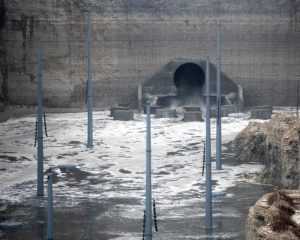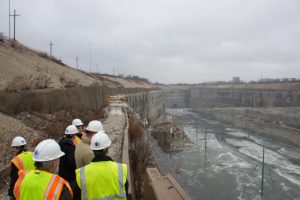For the first time, water came gushing into the Metropolitan Water Reclamation District of Greater Chicago’s (MWRD’s) McCook Reservoir Thursday, demonstrating a fully functioning system designed to prevent polluted water from entering local waterways and mitigate area flooding.
The reservoir started to take on water at approximately 9:30 a.m. from the Mainstream Tunnel System just minutes after the gates were opened from the tunnel. The initial inflow of water entering the reservoir was 263 million gallons of water, accounting for mainly rain water and snowmelt. With forecasts calling for additional rain, more water was expected throughout the day.

McCook Reservoir Stage 1 started to take on water at approximately 9:30 a.m. from the Mainstream Tunnel System just minutes after the gates were opened from the tunnel on Jan. 11.
The reservoir will contain water that formerly flowed directly into area waterways before it could be treated and cleaned. This stored water in the reservoir will be pumped from the reservoir to the Stickney Water Reclamation Plant to be cleaned and released when the treatment plant has capacity to treat the water after significant rain events.
“Yesterday’s initial flow of water may only climb up a small portion of the sprawling 300-foot walls of the reservoir, but this first fill reveals a working system that will protect our waterways from untreated water and our streets and basements from flooding,” said MWRD President Mariyana Spyropoulos.

MWRD engineers stand at the southwest corner of stage I of the McCook Reservoir as it begins to take on water for the first time on January 11, 2018.
Stage I of the McCook Reservoir can hold 3.5 billion gallons of storage capacity; water will be pumped through the existing Mainstream Pumping Station that has 8 centrifugal pumps with capacities ranging from 160 to 330 cfs and up to 330 feet of pressure head. The McCook Reservoir is designed to protect residents of Chicago and 36 suburban communities from flooding and will provide an estimated $114 million per year in flood reduction benefits.
Funded by the MWRD and the U.S. Army Corps of Engineers, McCook Reservoir is located along the Stevenson Expressway between the Des Plaines River and Chicago Sanitary and Ship Canal. It is part of the MWRD’s Tunnel and Reservoir Plan (TARP), one of the country’s largest public works projects for pollution and flood control. TARP covers a 375-mile area that includes Chicago and 51 suburbs that rely on a combined collection system that conveys both stormwater and used water.
About the Metropolitan Water Reclamation District of Greater Chicago
Established in 1889, the MWRD (www.mwrd.org) is an award-winning, special purpose government agency responsible for treating used water and managing stormwater in Cook County, Illinois.





Comments